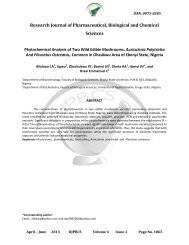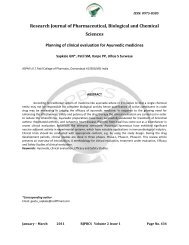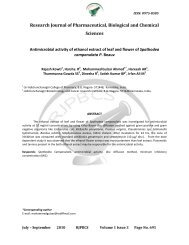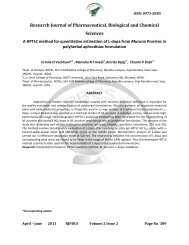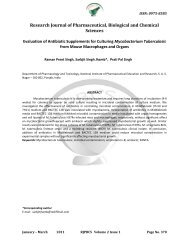Research Journal of Pharmaceutical, Biological and ... - RJPBCS
Research Journal of Pharmaceutical, Biological and ... - RJPBCS
Research Journal of Pharmaceutical, Biological and ... - RJPBCS
You also want an ePaper? Increase the reach of your titles
YUMPU automatically turns print PDFs into web optimized ePapers that Google loves.
ISSN: 0975-8585<br />
Camellia sinensis: (Family: Theaceae; Common name: Tea). There are many potential health<br />
benefits from drinking tea. There is lots <strong>of</strong> interest among researchers on the effect <strong>of</strong> tea on<br />
cardiovascular disease. <strong>Research</strong> on tea <strong>and</strong> HTN is contradictory. <strong>Research</strong> on black tea<br />
(fermented tea) (Camellia sinensis) shows no effect on BP in people with HTN. Population<br />
research links consumption <strong>of</strong> green tea (unfermented) (Camellia sinensis) <strong>and</strong> oolong tea<br />
(partially fermented) (Camellia sinensis) with a decreased risk <strong>of</strong> developing HTN.. [29]<br />
Capparis cartilaginea: (Family: Capparaceae; Common name: Lasaf). It has been reported that<br />
crude extract <strong>of</strong> C. cartilaginea produces a dose-dependent decrease in BP <strong>and</strong> slight<br />
bradycardia in anesthetized rats. [30]<br />
Carum copticum: (Family: Umbelliferae; Common name: Ajwain). The crude extract <strong>of</strong> C.<br />
copticum (1-30 mg/kg) produces a fall in BP <strong>and</strong> heart rate (HR) <strong>of</strong> anesthetized normotensive<br />
(NMT) rats. Hypotension produced is very brief <strong>and</strong> returns to normal within a minute. At the<br />
low dose (up to 1 mg/kg), the crude extract produces negligible change in the HR. However,<br />
bradycardia has been reported at the higher doses (10-30 mg/kg). [31]<br />
Cassia absus: (Family: Caesalpiniaceae; Common name: Chaksu). This plant is found in the<br />
tropical region <strong>and</strong> is found everywhere in India. It has been reported that an intravenous<br />
administration <strong>of</strong> a crude extract <strong>of</strong> C. absus produces a dose-related (1-30 mg/kg) decrease in<br />
BP, accompanied with a decrease in HR at the higher doses (10 <strong>and</strong> 30 mg/kg). Repeated<br />
injections <strong>of</strong> the same dose <strong>of</strong> the crude extract have been seen to produce tachyphylaxis. A<br />
sustained fall in BP <strong>of</strong> anesthetized animals <strong>and</strong> weak antiacetylcholine effect has been<br />
reported. [32]<br />
Cassia occidentalis: (Family: Caesalpiniaceae; Common name: C<strong>of</strong>fee weed). It is a small tree<br />
growing 5 to 8 m in height. The leaf <strong>of</strong> this plant is used in local folk medicine as an<br />
antihypertensive agent. In vitro studies <strong>of</strong> the leaf extract have shown a relaxant effect on the<br />
aortic rings. The studies revealed that cassia extract may be relaxing smooth muscle <strong>and</strong><br />
reducing BP by inhibiting Ca 2+ influx through receptor-operated channel <strong>and</strong> voltage-sensitive<br />
channel, showing its nonselectivity on these Ca 2+ channels. [33]<br />
Castanospermum austral: (Family: Fabaceae; Common name: Black bean). Crude extract <strong>of</strong> C.<br />
australe has been reported to cause a fall in systolic as well as diastolic BP in a dose-dependent<br />
manner (1-100 mg/kg). This fall in BP has been attributed to the saponin fraction <strong>and</strong><br />
medicogenic acid glucoside present in the crude extract. [34]<br />
Coleus forskohlii: (Family: Lamiaceae; Common name: Karpurvali). The pharmacological<br />
properties <strong>of</strong> coleonol, a diterpene, isolated from C. forskohlii, have been investigated. Its<br />
predominant effect has been to lower the BP <strong>of</strong> anesthetized cat <strong>and</strong> rat as well as <strong>of</strong> the<br />
spontaneously hypertensive rat due to relaxation <strong>of</strong> the vascular smooth muscle. [35]<br />
Commelina virginica: (Family: Commelinaceae; Common name: Virginia dayflower). It is a<br />
perennial herbaceous plant in the dayflower family. It is native to the mideastern <strong>and</strong><br />
April – June 2012 <strong>RJPBCS</strong> Volume 3 Issue 2 Page No. 680



